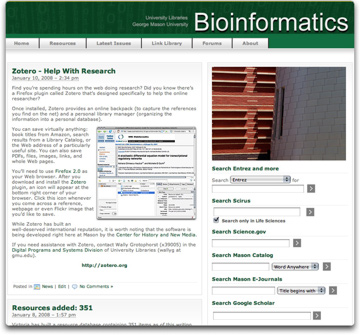Work on our first research portal (Bioinformatics) is just about complete.
To refresh, we’re combining two open-source products (WordPress and CWIS) to build what we hope will prove to be a valuable first-stop for Mason’s bioinformatics researchers. It is also a developmental template—one we’ll use to create additional portals for different subject areas. That work has already begun: in a few more weeks we hope to be near completion of another portal, this time for the Department of Communication.
 One immediate benefit we’re seeing: WordPress makes the process of building a different look for each portal relatively simple (just tweak a theme) and widgets open up a host of ways to customize each portal’s functionality.
One immediate benefit we’re seeing: WordPress makes the process of building a different look for each portal relatively simple (just tweak a theme) and widgets open up a host of ways to customize each portal’s functionality.
Victoria Shelton (our Bioinformatics Liaison Librarian) designed this portal’s resource classification scheme and then added over 350 web-based resources to the database. Here in the DPS division, after getting the basics set up and integrated we’ve spent our time adding new capabilities to the administrative module that ships with the CWIS software.
Our latest additions:
- check resources database for duplicates
- report broken links in resources database
- report resources that do not have a sample screen illustration
We’re now working on the documentation that will support creation of additional portals here at Mason and give us a document we can share with others who might wish to head down this path.
LibGuides
Clearly, a librarian serving as curator for one of these research portals will be doing quite a bit of work–identifying new resources, writing blog entries, chatting with clients, performing maintenance on links and more. I think it’s just as clear that not every subject merits this level of involvement/effort. Our intention is to build a portal for those programs with intensive graduate-level activity and use more traditional subject guides for other areas (e.g., perhaps course-oriented guides for undergraduates). At the moment I’m leaning toward licensing the LibGuides service from Springshare for this complementary purpose.
 I haven’t spent a lot of time looking at the LibGuides site but then it doesn’t really require in-depth study to get a sense of what they’re providing. The integration with Facebook is a real plus as are little touches like RSS feeds, ‘widget’ linking to courseware products (like WebCT), usage stats, polls, comments, chat integration—well, the feature list is a long one.
I haven’t spent a lot of time looking at the LibGuides site but then it doesn’t really require in-depth study to get a sense of what they’re providing. The integration with Facebook is a real plus as are little touches like RSS feeds, ‘widget’ linking to courseware products (like WebCT), usage stats, polls, comments, chat integration—well, the feature list is a long one.
To be honest, I’m most excited by a feature that’s really just a by-product of using the software: without even trying, all our subject guides will end up with a similar look and feel. That would be a huge improvement (this page always reminds me of one of those “memory games” that children play—only here you’re trying to remember which pages have matching styles).
Even though Mason would come in at the upper end of Springshare’s licensing fee range, I think we’d find that over the course of 3-4 years it was less expensive than funding the development of a comparable capability in-house.
Will report back after I gather some feedback on the idea from our public services staff and conduct a bit more research on the quality and reliability of service that Springshare delivers current customers.
Powerbook Surgery
The “failing” message I saw when checking the S.M.A.R.T. status on the out-of-retirement 12″ Powerbook I mentioned last week was right. The drive died. I was able to install a replacement drive in just under an hour but these 12″ machines pose a greater challenge than the more recent Macbook Pro. And yes, the 7200 rpm drive does improve the machine’s speed–the 1.33 GHz now feels more like a 1.67 GHz Powerbook.
Beyond needing a T6 Torx wrench to make this repair, here are two other things you’ll find useful should you want to consider this DIY project:
- a screw guide (basically a piece of paper with outlines of all the screws so you can keep track of them as they’re removed—and put them back where they belong.
- a take-apart guide (step by step how-to on disassembly).
